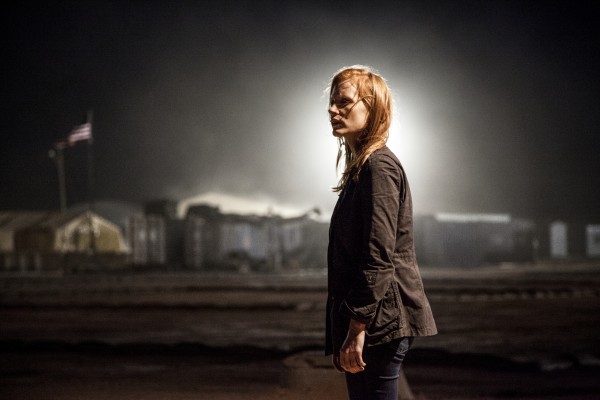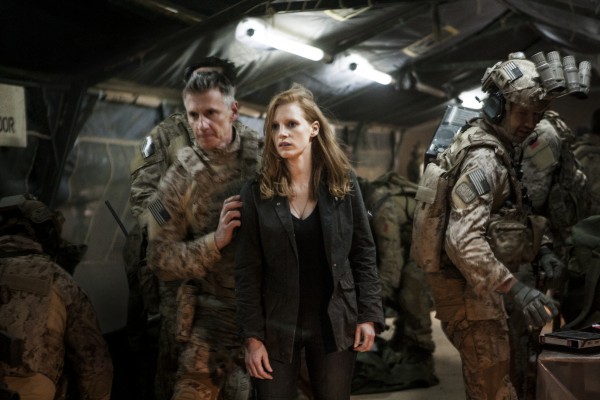-
A Spreadsheet with Feelings: Zero Dark Thirty
by Joseph Jon Lanthier December 20, 2012
“If you don’t want to kill anyone, that’s something you’re going to have to live with the rest of your life.”
- Jack Burns, on draft dodgersAt the start of what proves the most propulsive section of Kathryn Bigelow’s Zero Dark Thirty, a CIA operative we’ve come to know only as Maya (Jessica Chastain) demystifies the details of an incipient top-secret mission to an assembly of Navy SEALs. “There are two narratives about the location of Osama bin Laden,” she begins, and the jaws briskly drop around her.
What Maya then proceeds to describe aren’t really narratives, per se; they’re hypotheses as to where this number one most-wanted terrorist might be hiding, the discovery of which has been both her personal obsession and vocational objective for nearly a decade. But her initial terminology is slyly implicative. Ever since the World Trade Center attacks in 2001 catapulted the Islamic extremist to household infamy, two ur-stories—each demanded by either side of America’s deep, if ultimately semantic, political fissure—regarding his acrimonious relationship with the United States have been pervasive.
One of these (the one virtually ignored by Zero Dark Thirty, it must be said) begins in the 1980s, involves some shady firearm exchanges between Americans and Saudi rebels, and ends, inevitably, with botched relations, half-hearted occupation, and jihad. (Or, if you prefer, it ends with Hollywood revisionism and Tom Hanks.) The other narrative takes an expository shortcut through a path pocked with rhetorical landmines: one culture abhors the freedom of another (as well as perhaps the means by which the latter culture attempts to spread that freedom around) and seeks to intimidate it with violence, to which the enviably liberated nation can only respond with justified vengeance. Because these two variations are often and predictably used as rejoinders to one another in cross-partisan bandying, one assumes that the “truth” lies somewhere in between—in the muddle of ideological fusillades. But this is perhaps beside the point. Whatever chunks of detail might get expurgated for the sake of scholarship or jingoism, the plot remains haunting. Laying blame does nothing to assuage the familiar if still unprocessed sting delivered by both stories.
Zero Dark Thirty‘s most commendable accomplishment is that it does not require the former bin Laden narrative in order to question the validity of the latter. The film’s conscious omission of anything that might resemble a coherent motive for its primary, if mostly phantom, antagonist never skirts partisanship, and never engenders cheap triumphalism. To summarize the purposefully lopsided approach taken by Bigelow and her scenarist Mark Boal—to wit, their dramatization of Department of Defense mythologies with C.S.I.-like tension-mongering tricks—is to suggest that they’ve written history with lightning. And yet the movie is anti-historical; its hyper-specificity toward time and place (often signaled by what becomes a veritable barrage of scene-punctuating title cards) never bothers with context, with the “how” or “why” of “what” is happening. Operation Cyclone is hardly a glimmer in any high-ranking official’s eye, and use of the words “Muslim” and “Islam” could be counted on fingers and toes. The film even eschews history in the New Journalism reportage, can-you-feel-the-heat-of-the-moment sense of the word. It willfully resists the urge to chain events into logical sequences suggestive of believable temporality, instead following Maya’s quest with scene-piling linearity. (Though we spend most of the running time with the same characters, none of them age plausibly, and years can flick by in seconds for the sake dramatic expediency.)
But as is often the case, what the film negates stylistically is more flatly evident than what it promotes. Over the course of two and a half hours, Bigelow gradually implicates cost as her primary concern, especially human cost, and the way in which it appears to stand (the way in which it should stand) outside the smear of time, historical context, and what generally constitutes storytelling competency. To realistically study the cost of waging a war on terror, Bigelow proffers not only facsimiles of both torture and death, but of legislative rigmarole and bribery—all of which manage, remarkably and riskily, to evade connotations outside of their proposed transactional value. This discouragement toward “cultural” or “narratological” readings of individual scenes provokes us instead to ask again and again of the content: “Is this act worth what it appears to be worth?” In one memorable scene, a CIA official loosens the tongue of a Kuwaiti informer with a Lamborghini that might as well have “USA TAX DOLLARS AT WORK” emblazoned on its canary yellow spoiler. The gift provokes us in two ways that cancel one another out: are we really so spendthrift when it comes to intelligence, and are Arabs really so persuaded by invitations to cartoon decadence? After such less-than-sticky concerns disintegrate—and after the sequence’s flashy nature proves a narrative red herring—what remains is a rather simple exchange that may or may not have been prudent. The film is stuffed with such cells of ambiguously significant information; for all its jittery drama, Zero Dark Thirty might be the liveliest and the most morally pensive Excel spreadsheet ever made.
This filmmaker-as-accountant gambit is hardly bloodless. The nearly unwatchable opening sequences, for instance, throw us off the bean-counting scent that will become so odorous in the movie’s flabby middle. It all begins with a soundscape of trauma, a remixed selection of hideously tragic phone conversations that occurred during the September 11th attacks. (In the most discomfiting, a panicked woman trapped in the Twin Towers’ smoky blaze describes her last seconds of life to a 911 operator.) We’re then whisked to a torture chamber in an unidentified detainee camp, where two CIA agents with names that reek of code (Jason Clarke plays “Dan,” Chastain plays “Maya,” witnessing her first interrogation) bludgeon and water-board an al-Qaeda underling who is reluctant to surrender crucial, confidential knowledge. This first proper scene, which stretches on for several scabrous minutes, begs to be over-analyzed. The acidic, piss-colored light streaking the tin and wood walls of the “interview” cloister inverts the beatific golden beams in which martyrs are swaddled; Dan’s frat-house sadism (“Everybody breaks, bro. It’s biology.”) and Maya’s steely, clearly revulsion-repressing countenance create a good cop-bad cop/daddy-mommy dynamic, though the characters don’t sustain these roles elsewhere to suggest that they’re outcroppings of authentic personality; the close-ups and sound design are crunchily, sloshily, sweatily ruthless.
That the most lurid human rights violations rendered in the movie are planted directly after aural reminders of 9-11′s horrors is, however, hardly a casual juxtaposition. The interrogation vignette exists primarily to ask if such torture can be justified as a response to the most fatal act of terrorism committed in the United States—to ask if it is reasonable to fight fire of this monstrous kind with teratoid conflagrations of our own. This is in other words no ordinary spreadsheet; the usual hotkeys fail us immediately, and the question of whether or not the books can be balanced in spite of these two outliers echoes throughout the remaining ingress and egress of capital. To ensure the lucidity of this inquiry, Bigelow allows us to experience the torture primarily from the prisoner’s perspective, dog collar and all, even while his personality remains unknown; the value of such tactics eventually must be determined without baroquely humanizing those who suffer at the wrong end of them. (Does it matter what kind of human he is, so long as he is one? And then: Is it worth subjecting any human being to this, regardless of what he might know?)
Though crescendos and ritards of violence define the film’s rhythm, our lack of sustainable disgust allows for intellectualizing like the above paragraphs to occur quite readily. As visceral as the variants of brutality are, they aren’t enacted upon anybody in particular, even where white US citizens are concerned. In one clunky passage, a female CIA official is “punished” for her reckless hubris by a suicide bomber, yet even she’s a cipher, and as unfair as the plot turn appears it provides a hard lesson about the importance of defending without exception against net loss. Scenes, like the numerical catalogues of the killings (withdrawals) or intelligence-gathering events (deposits) they depict, turn into homogenous cells on a grid; their only defining factor is a sense of magnitude. The perilous man-hours spent tracking bin Laden are felt more than the men, or (in the most evident elision of “humanity”) their ethical perspectives toward violence.
President Obama makes a background cameo by way of television at one point to herald a moratorium on grisly interrogation tactics, but the proclamation’s effects are felt as forward- rather than backward-moving; it incites mild frustration about the future rather than contrition over the past among the agents. The film doesn’t necessarily dissuade us from believing that any of its characters experience (off-screen) remorse over such strategies, it simply asserts that such feelings are inessential to the story’s focus—falling as they do well outside of the scope of the stereotypically qualitative g-man ethos, the terms of which Bigelow approaches with putative naivety. Toward the end, a roundtable of officials weigh in on the probability that bin Laden is indeed where Maya believes him to be, and the dialog is finally reduced to the blissfully compact recitation of percentiles.
The closest thing we’re offered to an emotional center is in how the petty political back and forths shamelessly pull us toward sympathy for Maya’s efforts, in particular those to locate bin Laden’s most trusted courier in Pakistan. (Find him and you’ve found bin Laden, she thinks, though her commanders are hard nuts in need of cracking on this point.) In one labored device, Maya even scrawls angry notes on her supervisor’s office window with a Sharpie, inciting him to act. She is, in effect, writing on the glass ceiling, and Bigelow is testing us again: can distaff labor empowerment allow the spreadsheet to achieve equilibrium? (Is this worth that?) Maya doesn’t humanize the agency’s dubious methodology—far from it—but her self-engulfing, gender-promoting urge to consolidate a few irritating figures becomes contagious. Who isn’t similarly bothered when his or her accounts are out of whack? Who isn’t similarly driven to distraction by bosses undeserving of their magisterial appointments?
The film’s spreadsheet structure and Maya’s cloying adherence to career girl tropes (“It’s her against the world,” intones one of her long-suffering superiors) are thus ways of reifying the movie’s larger than life topic. TV conventions and tightwad budgeting are some of the few languages most Americans speak; Bigelow converts the jargon of the good folks who are perpetuating the United States’ global hegemony into another dialect of this middlebrow vernacular. The cast, similarly, is littered with instantly recognizable TV personalities who can now only play toward or against type (James Gandolfini, Chris Pratt, Kyle Chandler), and who act by way of bathetic conceit as our friendly ushers into this unknowable field. These tropes and stock players are so earnestly interpolated, meanwhile—and so damn welcome, after the gut-twisting exordium—that we don’t recognize until the film’s final moments how Bigelow has been pushing against them all along. A dual-pronged point emerges: that our foreign policy numbers don’t always add up, and that the postcard-thin tokens of confidence we’re allowed by the insularity of mass culture don’t facilitate the invincible arrogance we’d need to dismiss those numbers altogether.
Bin Laden’s assassination is thus staged like an elaborate act of terrorism, though this isn’t immediately perceptible in the heart-pumping, 24-like sheen of excitement through which it’s filtered. The Navy SEALs drop from helicopters into the compound, blasting their way through a handful of innocents while threatening to kill several more that are gathered like spectators to an execution in nearby roads and on adjacent rooftops. And yet the preemptive justification offered for this act earlier in the film—that many deaths around the world are still flowing freely from bin Laden’s leadership—is articulated angrily by Maya, to her superior, in an exchange that’s only a few emotional degrees from Mary Tyler Moore and Ed Asner. (Tragedies within tragedies: It’s worth noting that cinema itself has so few antecedents for this pedigree of female agency that televisual ones must be appropriated out of sheer necessity, possibly inadvertently. What other relatable traditions of this nature exist aside from “you just might make it after all”-isms?) The wild incongruity between the event being referenced and the cowgirl histrionics Bigelow uses to explore it brings the political complexities of bin Laden’s capture crashing beautifully down to earth, down to MTM Enterprises’ gender clichés and the ostensibly open-ended if suspiciously tit-for-tat murder of HBO and Showtime programming.
In the last ten minutes, the wreck reveals itself. The film’s tone swerves abruptly from conviction into bewilderment, and both the Navy SEALs and Maya are silently stunned at what they’re able to pull off. The latter, observing the feed from the soldiers’ night vision helmets at a safe distance, covers her mouth with her hand in an obvious reference to Hillary Clinton’s vulnerable stance in the now-iconic “Situation Room” photo. Bin Laden’s slayer, being whisked back to Afghanistan in a helicopter, compulsively undersells his achievement by claiming that he “killed the third level guy.” Maya, afterward unzipping a body bag to confirm bin Laden’s identity, has the somnolence of a pallbearer. (We, of course, never get a good, solid look at this objet petit a; the film convinces us that we don’t want, finally, what we essentially came to see.) Only moments later in the movie—though somewhat further along in the story’s timeline—Maya breaks down in ambiguous tears as she prepares to depart from the Middle East, her mission finally accomplished.
What this valedictory stream precisely communicates is less important, perhaps, than the fact that it fails to offer easy catharsis. The numbers look balanced, but determining whether there’s a standing surplus or deficit is impossible. In that way, Zero Dark Thirty‘s structure mirrors almost exactly that of another famous manhunt film: Fritz Lang’s M, wherein an hour or so of tense investigative detail is bookended by a senseless murder at one end, and a woman weeping over a retributive corpse at the other. In M, of course, the female in question was the mother of a pederast’s victim, and her mourning decried the fact that the criminal’s execution would not return her dead and defiled daughter to life and innocence. But in some respects Maya’s recondite outburst is a circumlocution of the same overwhelming confusion; the big, scary feelings that up until this point have been repressed by protocol finally squeeze through the protocol’s litany of pinhole leaks.
The old adage says that one death is a tragedy, while a million is a statistic; Zero Dark Thirty, with its preponderance of anonymous slaughters, says that they’re all statistics, and that this itself might be the tragedy. The experience of 9-11 can’t correspond to a data point or a primetime plot twist any more than the filthy stillness of bin Laden’s body can. The standard operating procedures have produced the desired results, but they fail to express accessible desire for those results, or relief at their attainment. One can have a rational motive for killing another human being; very many are offered throughout Zero Dark Thirty. But death itself is never rational. And so Bigelow’s spreadsheet becomes a prose poem—a koan deriving doubt from the moral imprecision of clean, worthy quantifiables. One tallies the cost as he might the stars.





